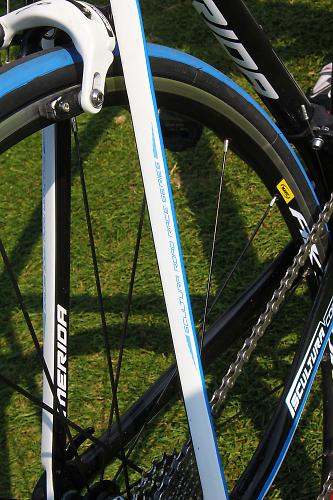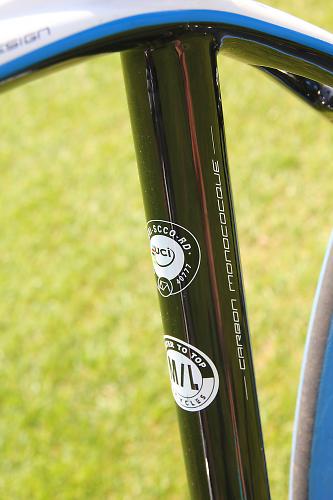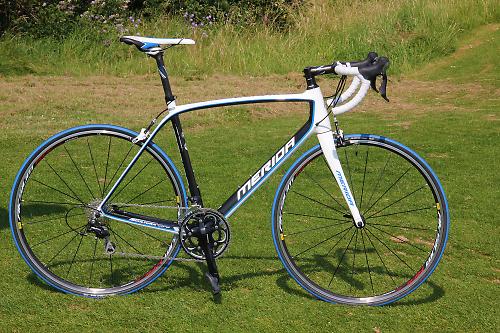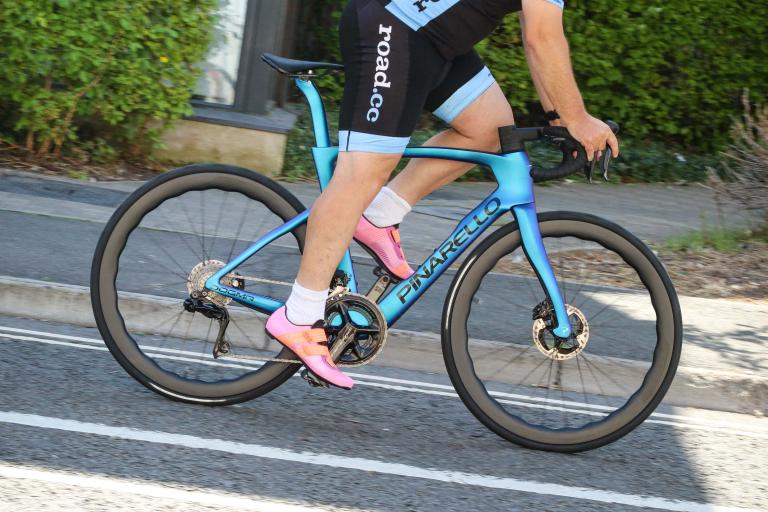- News
- Reviews
- Bikes
- Accessories
- Accessories - misc
- Computer mounts
- Bags
- Bar ends
- Bike bags & cases
- Bottle cages
- Bottles
- Cameras
- Car racks
- Child seats
- Computers
- Glasses
- GPS units
- Helmets
- Lights - front
- Lights - rear
- Lights - sets
- Locks
- Mirrors
- Mudguards
- Racks
- Pumps & CO2 inflators
- Puncture kits
- Reflectives
- Smart watches
- Stands and racks
- Trailers
- Clothing
- Components
- Bar tape & grips
- Bottom brackets
- Brake & gear cables
- Brake & STI levers
- Brake pads & spares
- Brakes
- Cassettes & freewheels
- Chains
- Chainsets & chainrings
- Derailleurs - front
- Derailleurs - rear
- Forks
- Gear levers & shifters
- Groupsets
- Handlebars & extensions
- Headsets
- Hubs
- Inner tubes
- Pedals
- Quick releases & skewers
- Saddles
- Seatposts
- Stems
- Wheels
- Tyres
- Health, fitness and nutrition
- Tools and workshop
- Miscellaneous
- Cross country mountain bikes
- Tubeless valves
- Buyers Guides
- Features
- Forum
- Recommends
- Podcast
review
£1,500.00
VERDICT:
Great upgradeable carbon machine with premium touches and gearing that'll suit sportives
Weight:
8,330g
Contact:
www.merida-bikes.com
At road.cc every product is thoroughly tested for as long as it takes to get a proper insight into how well it works. Our reviewers are experienced cyclists that we trust to be objective. While we strive to ensure that opinions expressed are backed up by facts, reviews are by their nature an informed opinion, not a definitive verdict. We don't intentionally try to break anything (except locks) but we do try to look for weak points in any design. The overall score is not just an average of the other scores: it reflects both a product's function and value – with value determined by how a product compares with items of similar spec, quality, and price.
What the road.cc scores meanGood scores are more common than bad, because fortunately good products are more common than bad.
- Exceptional
- Excellent
- Very Good
- Good
- Quite good
- Average
- Not so good
- Poor
- Bad
- Appalling
Merida have been gradually building up a road bike portfolio the last few years, from mainly mountain bike beginnings. The 2013 range is a comprehensive portfolio, with something for every end of the scale. On test is the Merida Scultura Comp 904, their second tier carbon frame fitted with Shimano 105.
Scultura is Italian for Sculpture (I'm trusting the Italian in the booklet here) and the frame does indeed follow a fine form. A flattened, slightly square section top-tube flows with a gracious, tapered curve into the seat-stays.

The seat-stays are narrow and also horizontally flattened for that vertical compliance along with solid power transfer that's common among bike frames these days.
At the front, a solid head-tube section splits into a large, again, slightly square, down-tube. All tell tale designs for the power transfer/vertical compliance balance.

The design is closely linked to the SL & Pro (higher end models). In fact, I am led to believe they are from the same mould. The difference is the lower modulus carbon used for the Comp's lay up - resulting in a 170g weight penalty and a lesser stiffness in exchange for lower production costs.
In many ways, this can be a better bike for many, creating a bike which has more give for a pleasant ride than a thoroughbred race machine. I found the Comp to strike a great balance between comfort and responsiveness; you still know you're riding a race bike but it doesn't make for too harsh a ride. The other upshot of using the same mould is that the bike is the first I've tested to be UCI approved, something perhaps beyond the target of this bike but a neat decal none the less.

Setting the bike fit up, I was surprised to find a full carbon fork - steerer included. Something saved for the top-end, it would certainly contribute to the comfort of the ride but also brings the overall build weight down. Weighing in at 380g for the fork, the total frameset is a claimed 1530g, which isn't half bad for a mid-range carbon bike. Our 54cm test bike added up to 8.6kg, a figure that, along with the strong feeling of power transfer, helps the bike to bring joy in the hills.

For me, it's a frameset above many of its mid-range carbon competitors, both in terms of feel and looks. I had no qualms throwing the bike into corners on descent and really hammering it like you would on the race circuit.
The frame uses a regular screw fit BB. It also includes integrated cabling that is compatible with electronic shifting. It's a neat feature for keeping the cables clear of grime and a bonus if you decide to upgrade the Shimano 105 to electric in the future. But changing the cables is more troublesome than exterior routing and the test bike had a rattle that after numerous searches, I was unable to pin down, leading me to suspect the cables were knocking inside the frame. Overall it completes a frameset with premium features beyond this bike's price point, so if you're looking at higher spec bikes but don't have the cash at the moment, this would make a worthy bike for trickle upgrades.

It's equipped with a Shimano 105 groupset, a solid offering from Shimano with little discernible difference, other than weight, to Ultegra or even Dura-Ace. The shifting is crisp, with in-line cable adjusters to adjust indexing on the fly. Brakes are one of the more telling groupset options and rather than use the 105 set, Merida have fitted their own, Merida Road Pro. I found the brakes to be good, with better stopping power than the 105 issue and a better build quality, with a full metal barrel adjuster for example.
A compact chainset and a whopping 12-28t cassette are fitted. I like this sensible gear selection; it makes the bike far more versatile, and overlooking the stigma of smaller gears, they are quite simply more pleasant for day to day riding and sportives - this bike's territory.

Wheels make a big difference to a bike and the Mavic Aksium have been selected here. They are a capable wheelset for the price, with nice features like press fit sealed bearings. They're built with durability in mind but I find them to be a bit sloppy ride wise, with not much 'life' to them.
While you certainly don't need to off the bat, they'd probably be my first upgrade. Vittoria Rubino Slick tyres complete the wheels. Slick by name, slick by nature, they look good in the shop but once the roads get wet, with no tread to shed water they are unnerving. I think a more all-round option would have been better here.

The bike is finished with some better-than-your-average OEM badged parts. A carbon seatpost and racy looking stem look great on the bike, along with slightly more average but perfectly capable Controltech alloy handlebars.

The Merida Scultura Comp is an eye-turner thanks to a design carried over from Merida's high end. It carries the image across well in the ride too and with the more than capable Shimano 105, it makes for a great value bike, which has potential as a base for other upgrades.
Wide gearing breaks from the mould of most carbon 'race' bikes, refreshing to see and allowing the bike to be a real all-rounder. It's an excellent choice for those looking for long days in the saddle and sportives.
Verdict
Good upgradeable carbon machine with premium touches and gearing that'll suit sportives.
road.cc test report
Make and model: Merida Scultura Comp 904
Size tested: 55cm
About the bike
State the frame and fork material and method of construction. List the components used to build up the bike.
Frame - full carbon.
Fork - carbon including steerer.
Bottom Bracket: attached
Brake Levers: attached
Brakes: MERIDA Road Pro
Chain: KMC X10 10s
Colour: black/UD carbon[yellow]
Crankset: Shimano R565 50-34
Derailleur Front: Shimano 105
Derailleur Rear: Shimano 105
Freewheel: Shimano CS-4600-10 12-28
Grips: Merida Road Pro 3D
Handlebar: Controltech ONE road OS
Headset: NO.55EP Neck-com
Hubs: attached
Pedals: NO
Rims: Mavic Aksium
Saddle: Selle Italia X1
Seatpost: MERIDA carbon twin SB19 27.2
Shifters: Shimano 105
Sizes: [44]-47-50-52-54-56-[59]
Speeds: 20
Spokes: attached
Stem: MERIDA pro E OS -7
Tyres: Vittoria Rubino Slick 23 60 KV
Wheel Size: 700c
Tell us what the bike is for, and who it's aimed at. What do the manufacturers say about it? How does that compare to your own feelings about the bike?
Merida's entry level race bike, it is a cheaper build of their top flight model, with longer chainstays for increased stability. I agree, especially given the compact chainset and wide cassette, it makes the bike more accessible to riders.
Frame and fork
Overall rating for frame and fork
9/10
Tell us about the build quality and finish of the frame and fork?
The frame looks great and has a quality finish. Paint seemed hard wearing and a good lacquer meant it was easy to clean despite being white. The full carbon steerer on the fork is a premium level item so nice to see.
Tell us about the materials used in the frame and fork?
Not the highest modulus carbon used in bike frames to bring the price down, the reduction in stiffness can be seen as a benefit to many as the ride is more cushioned. A full carbon fork helps to reduce road vibration.
Tell us about the geometry of the frame and fork?
It is a race geometry with quite short chain-stays (even though they have been reduced from the ProTour level frame) and shallow head-tube enlivening the steering. A shallow seat-tube also means you are quite forward over the pedals, I would have to swap the seat-post for the layback to get this bike to fit me.
How was the bike in terms of height and reach? How did it compare to other bikes of the same stated size?
I rode a 54cm and the fit was as I've come to expect from a race geometry. Quite a short top-tube but a 110mm stem is included to lengthen that. As I said above, the seat-tube seemed quite shallow.
Riding the bike
Was the bike comfortable to ride? Tell us how you felt about the ride quality.
The bike was comfortable but I still knew I was riding a 'race' bike; I could certainly feel every road surface I rode and anything bumpy was a bit jarring.
Did the bike feel stiff in the right places? Did any part of the bike feel too stiff or too flexible?
Yes, the bike hit the mark in terms of vertical compliance but horizontally stiff. It is bulked up in all the right areas: bottom bracket and head-tube.
How did the bike transfer power? Did it feel efficient?
Yes there certainly wasn't much flex, which made for a excellent feel up the hills or sprinting.
Was there any toe-clip overlap with the front wheel? If so, was it a problem?
No.
How would you describe the steering? Was it lively, neutral or unresponsive? Lively thanks to a short chain-stay and little rake.
Tell us some more about the handling. How did the bike feel overall? Did it do particular things well or badly?
The bike was stable. I felt in control and able to push it on descents. Only let down by the choice of tyre, which didn't inspire much confidence in the damp.
Which components had the most effect (good or bad) on the bike's comfort? would you recommend any changes?
The wide gearing makes for a much more enjoyable ride so plus points there.
I'd swap the tyres for something with a tread so once the rain clouds come in, your knuckles don't start showing.
Which components had the most effect (good or bad) on the bike's stiffness? would you recommend any changes?
If I wanted to stiffen the bike up, I'd swap the wheels for something else. That said, for the price they are more than capable.
Which components had the most effect (good or bad) on the bike's efficiency? would you recommend any changes?
Can't see any necessary changes here for the spec.
Rate the bike for efficiency of power transfer:
8/10
Rate the bike for acceleration:
8/10
Rate the bike for sprinting:
7/10
Rate the bike for high speed stability:
8/10
Rate the bike for cruising speed stability:
8/10
Rate the bike for low speed stability:
6/10
Rate the bike for flat cornering:
8/10
Rate the bike for cornering on descents:
8/10
Rate the bike for climbing:
8/10
The drivetrain
Rate the drivetrain for performance:
8/10
Rate the drivetrain for durability:
7/10
Rate the drivetrain for weight:
5/10
105 is nothing more than average here.
Rate the drivetrain for value:
9/10
Works just as well as Ultegra for a weight penalty.
Wheels and tyres
Rate the wheels and tyres for performance:
6/10
Only a bit above average. I like the Mavics for value but they aren't the stiffest. The tyres are strictly for dry.
Rate the wheels and tyres for durability:
6/10
No puncture protection and seemed to be wearing quite quick.
Rate the wheels and tyres for weight:
7/10
Rate the wheels and tyres for comfort:
7/10
The lack of stiffness does help to cushion the ride.
Rate the wheels and tyres for value:
7/10
Tell us some more about the wheels and tyres.Did they work well in the conditions you encountered? Would you change the wheels or tyres? If so, what for?
As said, the tyres are slick and strictly dry only. I'd swap for a tyre with tread and puncture protection such as a GatorSkin.
Wheels do the job but would be a worthwhile upgrade.
Controls
Rate the controls for performance:
7/10
Rate the controls for durability:
7/10
Rate the controls for weight:
5/10
Rate the controls for comfort:
8/10
I get on well with the Shimano hood shape. The bar tape was comfortable and grippy too.
Rate the controls for value:
6/10
Anything else you want to say about the componentry? Comment on any other components (good or bad)
A lay-back seat-post would be nice.
Your summary
Did you enjoy riding the bike? Yes.
Would you consider buying the bike? Yes.
Would you recommend the bike to a friend? Yes.
Rate the bike overall for performance:
8/10
Rate the bike overall for value:
7/10
About the tester
Age: 23 Height: 184cm Weight: 66kg
I usually ride: Orbea Onix (Carbon) - Summer, Orbea Asphalt (Alu) - Winter My best bike is: Orbea Alma G10
I've been riding for: Under 5 years I ride: Every day I would class myself as: Semi pro
I regularly do the following types of riding: road racing, time trialling, cyclo cross, club rides, mtb,
Latest Comments
- Jack Sexty 4 min 45 sec ago
Sorry, fixed the double entry! ...
- bobbinogs 4 min 57 sec ago
Ref TNT Sports, the way I see it is that VPN is only part of the answer since it then means watching some great cycling but in a foreign language....
- Rendel Harris 11 min 5 sec ago
Whilst one definition of aggressive is "prepared or ready to attack", something that does apply to a significant minority of drivers in any case,...
- SWILD 12 min 8 sec ago
The Rochdale Canal which runs alongside the A646 is suitable for for leisure cycling and is very pleasant. Admittedly, it is not suitable for...
- Steve K 18 min 5 sec ago
BMW Mini, not a proper one.
- SimoninSpalding 24 min 52 sec ago
I don't have a power meter but I have tried to gauge the effect of different positions on my bike for the same effort. I seem to get a fairly...
- rct 40 min 51 sec ago
See recently reported comments by elected labour party represenetives in Burnley to see how that works.
- hawkinspeter 2 hours 12 min ago
I often come into Bristol along the dual carriageway there as it's quicker than trying to find my way on the bike paths, but then I'm used to...
- hawkinspeter 4 hours 24 min ago
I re-fuse to believe that not charging drivers is the current attitude
- Matthew Acton-Varian 5 hours 19 min ago
Most modern cars, especially SUV's perform very badly on the Moose test. Essentially a stunt driver has to weave through tightly spaced cones at...






















Add new comment
4 comments
dont forget people, if you ride a Specialized, you ride a Merida....
Haven't ridden this one, but I've tried Merida Reacto and I think it's a decent bike. We'll see what they will develop with Lampre, especially in TT and Classics category (they don't hide it that they've got something up their sleeve).
Merida just confirmed as sponsoring Lampre next year instead of Wilier. They're riding the Pro version of this with other models released later on.